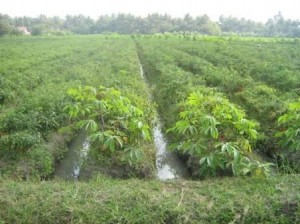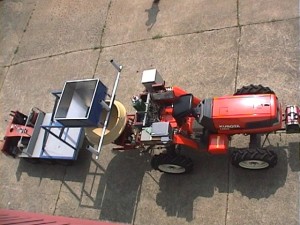Sep
09
2009
 Recently, the main challenge in the development of agricultural industry sector is the limited presence of the natural resources of agriculture, both in quantity and quality aspects. One of the natural resources that significantly degrade is an agricultural land area. The research was conducted for identifying the capacity of coastal area as one of the natural resources to support development of an agro-industry through introducing agricultural innovation technology. In this stage, outputs of the research were an information system for managing those innovation technologies and profile of the farming system in coastal area.
Recently, the main challenge in the development of agricultural industry sector is the limited presence of the natural resources of agriculture, both in quantity and quality aspects. One of the natural resources that significantly degrade is an agricultural land area. The research was conducted for identifying the capacity of coastal area as one of the natural resources to support development of an agro-industry through introducing agricultural innovation technology. In this stage, outputs of the research were an information system for managing those innovation technologies and profile of the farming system in coastal area.
Research mechanisms include: (i) identification of system parameters through field observations, (ii) preparation of model development system, (iii) development of software-based GIS, (iv) validation and verification of systems with field data acquisition, and (v) standardization system. The developed model was tested in three districts in Province Yogyakarta, namely (i) Bantul, (ii) Kulon Progo and (iii) Gunungkidul. (published by Journal of Agritech 30(2) 2010 – Universitas Gadjah Mada)
Sep
04
2009
 The second part of the study was to validate the developed information system in a selected farming area. For the primary data, a farm survey was conducted in Sleman Regency, Yogyakarta Province. The sixty (60) household farms in 6 (six) districts were investigated which were grouped into animal based and tractor based farms.
The second part of the study was to validate the developed information system in a selected farming area. For the primary data, a farm survey was conducted in Sleman Regency, Yogyakarta Province. The sixty (60) household farms in 6 (six) districts were investigated which were grouped into animal based and tractor based farms.
Based on the farm survey, the results described that the total annual water surplus in the study area was 792 mm that reached from November to April and water deficit was 355 mm from May to October. There is also surplus situation of number of animal drawn and local equipment for land preparation in each district, but deficiency in number of power tiller and it’s matching tillage equipment. The sensitivity analysis indicated those yield and crop price are the most significant factor in determining the net return of the crop production system.
Sep
04
2009
 This study was undertaken to develop a computer program package for identifying a farming system that was focused in the water availability analysis, the optimizing of agricultural power and selected equipment and the sensitivity analysis. The computer programs for all models were developed and written in FoxBASE command language. Three databases were obtained from the farm survey i.e.; climate, crop and power. All these databases can be appended, edited, deleted or displayed by the users through a menu of database management system (DBMS). They were used to evaluate the utility of the computer programs as input data. The information system calculates the amount of monthly water surplus and deficit, the optimum number of agricultural power (animal or power tiller) and its matching implement required and also change in the net return of crop production system due to the change of input variables such as crop price, yield, and production material cost. The system output for each analysis can be presented in three options by screen, printer and file that can be accessed to another language.
This study was undertaken to develop a computer program package for identifying a farming system that was focused in the water availability analysis, the optimizing of agricultural power and selected equipment and the sensitivity analysis. The computer programs for all models were developed and written in FoxBASE command language. Three databases were obtained from the farm survey i.e.; climate, crop and power. All these databases can be appended, edited, deleted or displayed by the users through a menu of database management system (DBMS). They were used to evaluate the utility of the computer programs as input data. The information system calculates the amount of monthly water surplus and deficit, the optimum number of agricultural power (animal or power tiller) and its matching implement required and also change in the net return of crop production system due to the change of input variables such as crop price, yield, and production material cost. The system output for each analysis can be presented in three options by screen, printer and file that can be accessed to another language.
Sep
04
2009
 A control method for autonomous vehicles was developed to steer the vehicle to a given goal point. Since four wheeled vehicles have constraints known as non-holonomic constraints, a nonlinear control theory was applied to generate a trajectory that would permit a vehicle to run from a starting point to the goal within these constraints by tracking it.
A control method for autonomous vehicles was developed to steer the vehicle to a given goal point. Since four wheeled vehicles have constraints known as non-holonomic constraints, a nonlinear control theory was applied to generate a trajectory that would permit a vehicle to run from a starting point to the goal within these constraints by tracking it.
In this study, the trajectory control algorithm was applied to automatic fertilizer refilling with an autonomous vehicle equipped with a broadcast fertilizer distributor. Since the proposed control algorithm was an open-loop control, disturbances such as slippage of wheels caused navigation error.
To minimize error, feedback terms were added by linearizing the vehicle’s kinematic equations around a nominal trajectory generated with the open-loop algorithm. A fan beam type laser sensor was used for finding and positioning a fertilizer supplier on which light reflectors were attached for positioning. The accuracy of the control was examined by simulation and field experiments.
The field experiments were repeated by changing postures of the autonomous vehicle with the container at the start point. Results of the field experiment showed that the algorithm could guide the vehicle with satisfactory accuracy for refilling. The main factor in navigation error was limitation in the steering angle of the front wheels.(funded by : Ph.D Program Dissertation – Monbusho Japan 1997-2001 – supervised by : Prof. Tomohiro TAKIGAWA)
Sep
02
2009
 Sleman, as an area with rapid economic growth, against the challenge of development in relation with population expansion, local autonomy and good governance. In one hand, there is lack of synergy among development stakeholders, on the other hand information is ineffectively used during the decision making process. This paper aimed to develop a model of rural development plan based on agricultural sector using two computer softwares, i.e: (i) Geographical Information System (GIS) as spatial information system and (ii) Powersim to program the dynamic system behavior.
Sleman, as an area with rapid economic growth, against the challenge of development in relation with population expansion, local autonomy and good governance. In one hand, there is lack of synergy among development stakeholders, on the other hand information is ineffectively used during the decision making process. This paper aimed to develop a model of rural development plan based on agricultural sector using two computer softwares, i.e: (i) Geographical Information System (GIS) as spatial information system and (ii) Powersim to program the dynamic system behavior.
The model provides information on existing condition and consists of five components namely geography, development function, infrastructure, institution, and data catalog. The model was developed through formulating causal diagrams of development sectors and set it in a dynamic programming. The model was then validated in Moyudan, Sleman for the case of agriculture development, which is showed that the model was valid. (published by : Journal of Agritech, Fac. of Agricultural Technology UGM, Vol. 25 No. 1 2005 – co-authors : Sigit Supadmo A. and Murtiningrum).
Sep
02
2009
 The world demand of raw-silk provides a great opportunity to the development of raw-silk production in Yogyakarta. Recently, only 21% out of the overall world demand of raw-silk is fulfilled, whereas Indonesia contributes only 0.1% per year. The main problem is the lack of quality of raw-silk.
The world demand of raw-silk provides a great opportunity to the development of raw-silk production in Yogyakarta. Recently, only 21% out of the overall world demand of raw-silk is fulfilled, whereas Indonesia contributes only 0.1% per year. The main problem is the lack of quality of raw-silk.
The optimum growth of silkworm depends on micro environments, i.e. temperature, humidity, aeration, and light intensity. The research was aimed, to apply an automated “on/off” control technology in the silkworm rearing environmental monitoring. The result expected is high-grade quality of cocoon. In the research, two different conditions of silkworm growing environments were compared: controlled environment (in the rearing box) and normal environment. Then, from third instar (silkworm`s growth stage) to cocoon`s stage (final stage or fifth instar), temperature and air humidty were set on 240C – 260C and 70% – 80% respectively. While, Aeration and light intensity were ranged 0.1 – 0.3 m/s and 15 – 30 lux for all instar stages (constant) respectively.
The result indicated that there was an increasing the percentage of cocoon skin’s grade in the controlled rearing environment (19.66%), compared to the result of normal rearing environment (18.56%), also there was significantly different result on the thickness of the cocoon produced. (published by : Journal of Agritech, Fac. of Agricultural Technology UGM, Vol. 24 No. 4 2004 – co-authors : Atris Suyantohadi, Hari Purwanto, Radi)
 Recently, the main challenge in the development of agricultural industry sector is the limited presence of the natural resources of agriculture, both in quantity and quality aspects. One of the natural resources that significantly degrade is an agricultural land area. The research was conducted for identifying the capacity of coastal area as one of the natural resources to support development of an agro-industry through introducing agricultural innovation technology. In this stage, outputs of the research were an information system for managing those innovation technologies and profile of the farming system in coastal area.
Recently, the main challenge in the development of agricultural industry sector is the limited presence of the natural resources of agriculture, both in quantity and quality aspects. One of the natural resources that significantly degrade is an agricultural land area. The research was conducted for identifying the capacity of coastal area as one of the natural resources to support development of an agro-industry through introducing agricultural innovation technology. In this stage, outputs of the research were an information system for managing those innovation technologies and profile of the farming system in coastal area.



